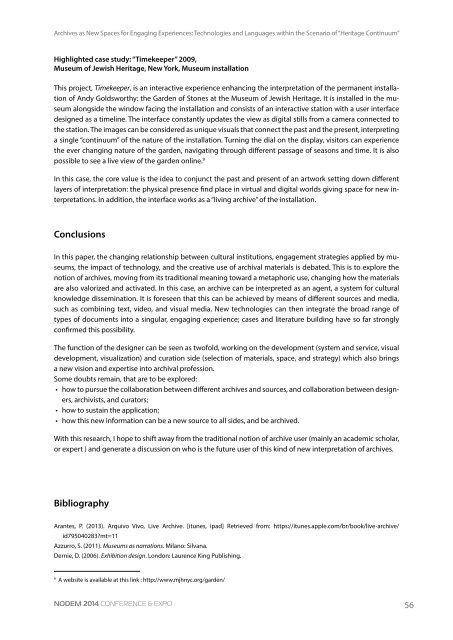NODEM 2014 Proceedings
NODEM 2014 Proceedings
NODEM 2014 Proceedings
You also want an ePaper? Increase the reach of your titles
YUMPU automatically turns print PDFs into web optimized ePapers that Google loves.
Archives as New Spaces for Engaging Experiences: Technologies and Languages within the Scenario of “Heritage Continuum”<br />
Highlighted case study: “Timekeeper” 2009,<br />
Museum of Jewish Heritage, New York, Museum installation<br />
This project, Timekeeper, is an interactive experience enhancing the interpretation of the permanent installation<br />
of Andy Goldsworthy: the Garden of Stones at the Museum of Jewish Heritage. It is installed in the museum<br />
alongside the window facing the installation and consists of an interactive station with a user interface<br />
designed as a timeline. The interface constantly updates the view as digital stills from a camera connected to<br />
the station. The images can be considered as unique visuals that connect the past and the present, interpreting<br />
a single “continuum” of the nature of the installation. Turning the dial on the display, visitors can experience<br />
the ever changing nature of the garden, navigating through different passage of seasons and time. It is also<br />
possible to see a live view of the garden online. 9<br />
In this case, the core value is the idea to conjunct the past and present of an artwork setting down different<br />
layers of interpretation: the physical presence find place in virtual and digital worlds giving space for new interpretations.<br />
In addition, the interface works as a “living archive” of the installation.<br />
Conclusions<br />
In this paper, the changing relationship between cultural institutions, engagement strategies applied by museums,<br />
the impact of technology, and the creative use of archival materials is debated. This is to explore the<br />
notion of archives, moving from its traditional meaning toward a metaphoric use, changing how the materials<br />
are also valorized and activated. In this case, an archive can be interpreted as an agent, a system for cultural<br />
knowledge dissemination. It is foreseen that this can be achieved by means of different sources and media,<br />
such as combining text, video, and visual media. New technologies can then integrate the broad range of<br />
types of documents into a singular, engaging experience; cases and literature building have so far strongly<br />
confirmed this possibility.<br />
The function of the designer can be seen as twofold, working on the development (system and service, visual<br />
development, visualization) and curation side (selection of materials, space, and strategy) which also brings<br />
a new vision and expertise into archival profession.<br />
Some doubts remain, that are to be explored:<br />
• how to pursue the collaboration between different archives and sources, and collaboration between designers,<br />
archivists, and curators;<br />
• how to sustain the application;<br />
• how this new information can be a new source to all sides, and be archived.<br />
With this research, I hope to shift away from the traditional notion of archive user (mainly an academic scholar,<br />
or expert ) and generate a discussion on who is the future user of this kind of new interpretation of archives.<br />
Bibliography<br />
Arantes, P. (2013). Arquivo Vivo, Live Archive. [itunes, ipad] Retrieved from: https://itunes.apple.com/br/book/live-archive/<br />
id795040283?mt=11<br />
Azzurro, S. (2011). Museums as narrations. Milano: Silvana.<br />
Dernie, D. (2006). Exhibition design. London: Laurence King Publishing.<br />
9<br />
A website is available at this link : http://www.mjhnyc.org/garden/<br />
<strong>NODEM</strong> <strong>2014</strong> Conference & Expo<br />
56


